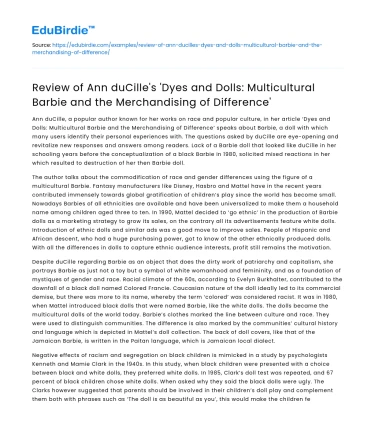Ann duCille, a popular author known for her works on race and popular culture, in her article ‘Dyes and Dolls: Multicultural Barbie and the Merchandising of Difference’ speaks about Barbie, a doll with which many users identify their personal experiences with. The questions asked by duCille are eye-opening and revitalize new responses and answers among readers. Lack of a Barbie doll that looked like duCille in her schooling years before the conceptualization of a black Barbie in 1980, solicited mixed reactions in her which resulted to destruction of her then Barbie doll.
The author talks about the commodification of race and gender differences using the figure of a multicultural Barbie. Fantasy manufacturers like Disney, Hasbro and Mattel have in the recent years contributed immensely towards global gratification of children’s play since the world has become small. Nowadays Barbies of all ethnicities are available and have been universalized to make them a household name among children aged three to ten. In 1990, Mattel decided to ‘go ethnic’ in the production of Barbie dolls as a marketing strategy to grow its sales, on the contrary all its advertisements feature white dolls. Introduction of ethnic dolls and similar ads was a good move to improve sales. People of Hispanic and African descent, who had a huge purchasing power, got to know of the other ethnically produced dolls. With all the differences in dolls to capture ethnic audience interests, profit still remains the motivation.
Save your time!
We can take care of your essay
- Proper editing and formatting
- Free revision, title page, and bibliography
- Flexible prices and money-back guarantee
Despite duCille regarding Barbie as an object that does the dirty work of patriarchy and capitalism, she portrays Barbie as just not a toy but a symbol of white womanhood and femininity, and as a foundation of mystiques of gender and race. Racial climate of the 60s, according to Evelyn Burkhalter, contributed to the downfall of a black doll named Colored Francie. Caucasian nature of the doll ideally led to its commercial demise, but there was more to its name, whereby the term ‘colored’ was considered racist. It was in 1980, when Mattel introduced black dolls that were named Barbie, like the white dolls. The dolls became the multicultural dolls of the world today. Barbie’s clothes marked the line between culture and race. They were used to distinguish communities. The difference is also marked by the communities’ cultural history and language which is depicted in Mattel’s doll collection. The back of doll covers, like that of the Jamaican Barbie, is written in the Paitan language, which is Jamaican local dialect.
Negative effects of racism and segregation on black children is mimicked in a study by psychologists Kenneth and Mamie Clark in the 1940s. In this study, when black children were presented with a choice between black and white dolls, they preferred white dolls. In 1985, Clark’s doll test was repeated, and 67 percent of black children chose white dolls. When asked why they said the black dolls were ugly. The Clarks however suggested that parents should be involved in their children’s doll play and complement them both with phrases such as ‘The doll is as beautiful as you’, this would make the children feel good about themselves.
Hopson in collaboration with Mattel they created a new Barbie who had unique body features like different color shades, different hair colors and texture that could create unique hair styles. This uniquely introduced doll was named Shani and she had all desirable features that encompassed the true African pride. What do we mean when we say a doll does or does not look black? How does black look like? What would it take exactly to make a doll look truly African American? These are some of the questions that come up when the issue of authenticity and realistically African American dolls come up with features such as fuller lips, broader nose and hips in mind. The author envisages what doll makers and other image creators in film would do to make dolls authentically African American without using the simplistic approach of big hips and lips. The author seeks to know what it would take to produce dolls that fully reflected the wide variety of shapes, sizes, color and hair that all African American, like all other people come with.
The author’s work on popular culture such as Barbie the doll ends in a fashionable and rather dramatic manner, in that she says Barbie is just a plastic, its effect on societal economy, gender and race is significant, and its negative impact is immense and not good for the society. As much as diversity in production of Barbie dolls is glorified, human curiosity and imagination on what an ideal doll should look like in the face of the vast human race is unimaginable and still remains a mythical mystery.






 Stuck on your essay?
Stuck on your essay?

